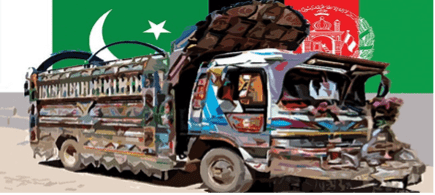
The Pak – Afghan trade relationship has been obfuscated due to political and economic turmoil caused by regional instability and international interventions. The key drivers of this tense relationship has been territorial sovereignty concerns, security, geopolitical dynamics, cross-border ties, and trade. Despite having means for developing a sustainable economy, the instability in Afghanistan has led the country to an economic downturn. Since the Taliban took over Afghanistan in 2021 the country’s economic condition has plunged into further crisis and uncertainty. This article addresses if US interventions were the only reason for poor trade between Pakistan and Afghanistan, wh2at element accelerated the trade since Taliban takeover, will it be a permanent rise or does it come with its own repercussions in terms of taxes, cross-border drug export. It also considers if the devalued currency of Afghanistan can be capable enough to maintain imports particularly with international restrictions on engaging with the Taliban government.
The Taliban seized power of Afghanistan mid-August as the last of the US-led coalition troops that had been supporting the previous government pulled out. But apart from a few countries, the broader international community has not yet recognized the current government. Billions of dollars of funding, assets and loans earmarked for government agencies and development and humanitarian services remain frozen.[1]
During the time of such a humanitarian crisis women and children are also exposed to extreme trauma, uncertainties and disrupted daily life where they are unable to perform day to day activities. For war ridden countries like Afghanistan that depend on aid and NGOs for healthcare, education and such facilities, the US exit became more than some political change. “The vulnerable segments of the society like children and women who aren’t allowed to work and earn a living for themselves are in dire need of assistance. Foreign aid largely funds all the food and healthcare facilities in Afghanistan. Since the exit of the US, access to healthcare and delivery of good quality food has been nearly impossible. Some international donors are looking for ways to hand out funds through non-governmental channels, but that has taken time”. [2]
On 10 December, donors agreed to release US$280 million to the United Nations children’s agency UNICEF and the World Food Programme to directly deliver essential health services and food assistance to more than 10 million people in the country.[3]
Afghanistan is a highly cash-reliant society. In 2020, nearly 85% of the adult population did not have a bank account, according to the World Bank. In September 2021, the UN warned that Afghanistan may face an economic collapse and resultantly a humanitarian crisis, partly because of its liquidity crisis but also due to a decline in foreign trade.[4]
It would be unfair to blame the Taliban solely for the current economic crisis since the last governments themselves were unable to formulate sound economic policies. The policymaking process had been overshadowed with local political conflicts, foreign intrusions motivated by vested interests and border politics affecting the trade and economy directly. Apart from this, being heavily dependent on international aid created a stagnation in the economic growth and also generated a dubious image of Afghanistan as a global trade partner.
Afghanistan is a landlocked country that depends on transit routes for trade and also generates revenue from these routes through border charges and customs fees. But these trade routes have always been a reason for regional conflict, smuggling, loot and Taliban interventions, which is why it has never been able to generate enough revenue to impact the economic development of the country.
Pakistan and Afghanistan face their share of security, economic and political challenges and over the years, both countries have seen some of the worst economic shocks in terms of Taliban interventions and other international restrictions and discriminations. The War Against Terror focused primarily on Afghanistan has cost Pakistan a huge amount in terms of economic losses, regional instability, ethnic conflicts and an overall reputation of being unsade at international levels. During the last 13 years, the direct and indirect cost incurred by Pakistan due to incidents of terrorism amounted to US$ 102.51 billion equivalent to 8264.40 billion Pakistani Rupees.[5]
With the exit of US military troops from Afghanistan, the sitting federal government, unable to face the mess, escaped Afghanistan too, leaving behind the country in a fragile state with the Taliban in charge. As soon as the initial taking-over mayhem settled down, the Taliban who initially were only generating income through opium production, intercity bribes and other illegal sources took over the country’s economy and opened Afghanistan to international trade. Small businesses that once had to pay bribes to pass through various borders, soon were generating more as the mobility of trade was free with the Taliban imposing a ‘good ruler’ image.
During 2010, the two countries negotiated a robust Afghanistan-Pakistan Transit Trade Agreement (APTTA) with urging from the United States and support from the United Nations. “The agreement enacted counter-smuggling initiatives; reiterated a commitment to strengthening both countries’ customs facilities; enabled them to use each other’s rail, road, and airport infrastructure on certain routes; and provided for the one-way transfer of Afghan goods to India via the Wagah border crossing.”[6] In practice, however, interviewees from the trade and business communities on both sides concurred that compliance with the agreement is still lacking. Despite guaranteed access on set routes throughout Afghanistan and Pakistan, interviewees reported, both sides have curtailed this movement such that traders have to stop in the first major cities they reach after crossing the border—Jalalabad and Kandahar in Afghanistan and Peshawar and Quetta in Pakistan. “Afghan traders are thus unable to transit Pakistan to India as outlined in the agreement, a friction point between the two sides. Afghan traders also complain of costly documentation they are required to show at the port of Karachi and when crossing the border, over and above what is necessary under APTTA. Traders from both sides highlight corruption among border officials and police, who often demand bribes from those transiting.”[7]
Since the Taliban takeover, the export mobility through Baluchistan to Kabul and Kandahar has been accelerating, with Pak Afghan trade exceeding 50% than what it was before. Locals expressed their satisfaction over the current trading situation. “Earlier, the Afghan officials at the border and also at different check posts demanded bribes ranging between 10,000 to 20,000 Pakistani Rupees ($60 to $120 approximately) to allow our vehicles in their respective areas, Now, in last 20 days, no one has asked me to pay a bribe at the border or any check post”, said Abdullah, a truck driver from Khyber district.[8] Along with much better trade mobility, there has been less smuggling, the local businesses in Afghanistan have been able to gain profits without cuts and overall, there has been a sense of trust in the trading sector.
The Taliban proposed security for businesses, a hurdle free border, a sticker visa, reduction of taxes and revision of the previous policies. However, the Durand Line fencing is still a dispute that has been addressed by Pakistan but the Taliban, considering it a British colonial division, still disagree with it. Over the past years, this border has been one of the key modes of transportation, refugee influx and other territorial disputes leading to frequent skirmishes between Taliban and Pakistan security forces. Although these closures generate major losses for the predominantly Pashtun trading community, they can also revitalize lucrative smuggling routes: illicit trade reportedly tripled after routes were closed in 2017.[9]
The number of cross-border terror attacks from Afghanistan fell from 82 in 2019 to just 11 in 2020. Fencing of the border between Afghanistan and Pakistan has been initiated by Pakistan but this initiative has been met with a lot of criticism. According to locals the fences have had an adverse impact on many families that live across the borders and has not only led to numerous farmers selling their lands but has also affected many traders.[10]
There is a need for demand-based policies and implementation of regulations that will successfully bring peace and long-term security to the region. These are still under consideration as a peaceful economic cooperation between these two countries will help in connecting South Asian and Central Asian economies in return this bilateral trade will boost employment, better currency value and domestic economic stability.
About the author

Nimra Zahid Mir is an MPhilstudent at CPPG. Her research interests include Internally Displaced Persons (IDPs), education, leadership and institutional development.
References:
Basit, Abdul. “Pakistan- Afghanistan Border Fence, a Step in the Right Direction.” Aljazeera, February 25, 2021. https://www.aljazeera.com/opinions/2021/2/25/the-pak-afghan-border-fence-is-a-step-in-the-right-direction.
“Home – Ministry of Commerce | Government of Pakistan.” Ministry of commerce, Government of Pakistan, 2010. https://www.commerce.gov.pk/wp-content/uploads/pdf/APTTA.pdf.
“Impact of War in Afghanistan and Ensuing Terrorism on Pakistan’s Economy.” Ministry of Finance, Government of Pakistan , March 6, 2015. http://www.finance.gov.pk/survey/chapters_15/Annex_IV_War_on_Terror.pdf.
Jhanmal, Zabiullah. “Smuggling from Pakistan to Afghanistan Tripled.” Tolo news, March 13, 2017. https://tolonews.com/business/smuggling-pakistan-afghanistan-tripled.
Loft, Philip. “Research Briefings.” https://commonslibrary.parliament.uk/research-briefings/cbp-9343/#:~:text=It%20is%20highly%20dependent%20on,also%20a%20cash%2Dreliant%20society., April 1, 2022.
Sajid, Islam Ud Din. “Pakistan, Afghanistan Trade Soars Following Taliban Takeover .” Anadolu agency, September 15, 2021. https://www.aa.com.tr/en/asia-pacific/pakistan-afghanistan-trade-soars-following-taliban-takeover/2365139.
Threlkeld, Elizabeth, and Grace Easterly. “Afghanistan-Pakistan Ties and Future Stability in Afghanistan.” United States Institute of Peace, November 1, 2021. https://www.usip.org/publications/2021/08/afghanistan-pakistan-ties-and-future-stability-afghanistan.
Citations

